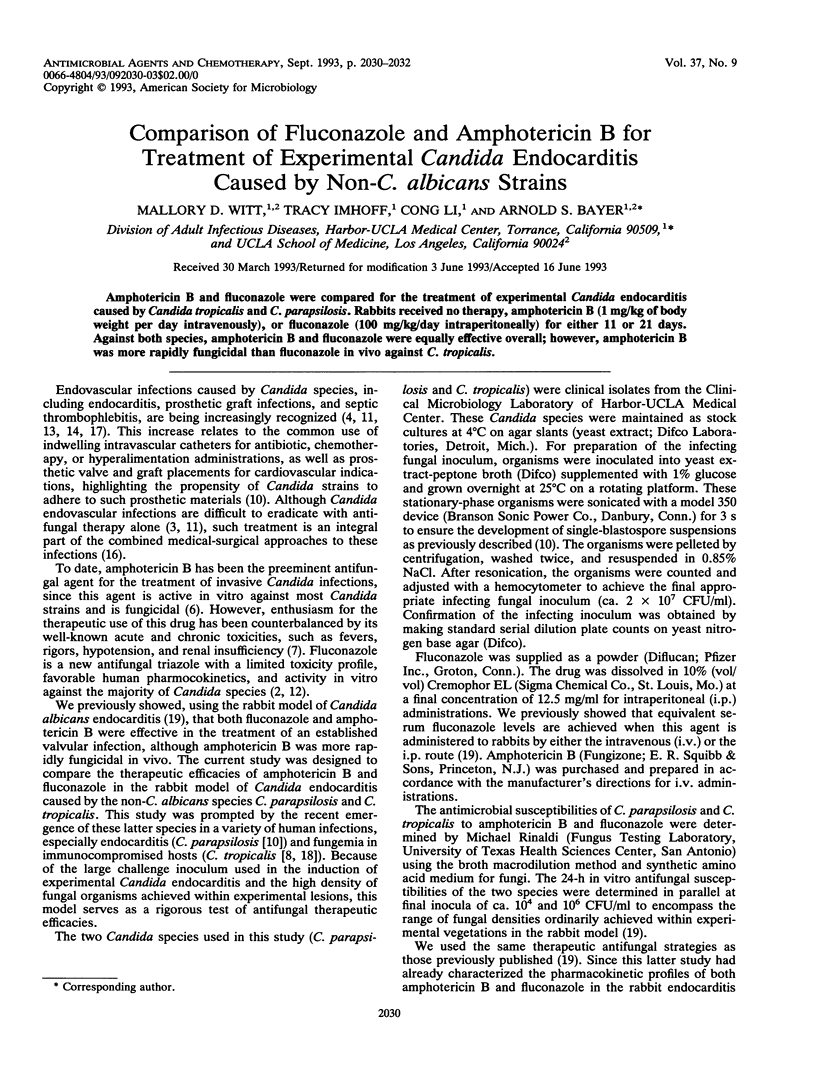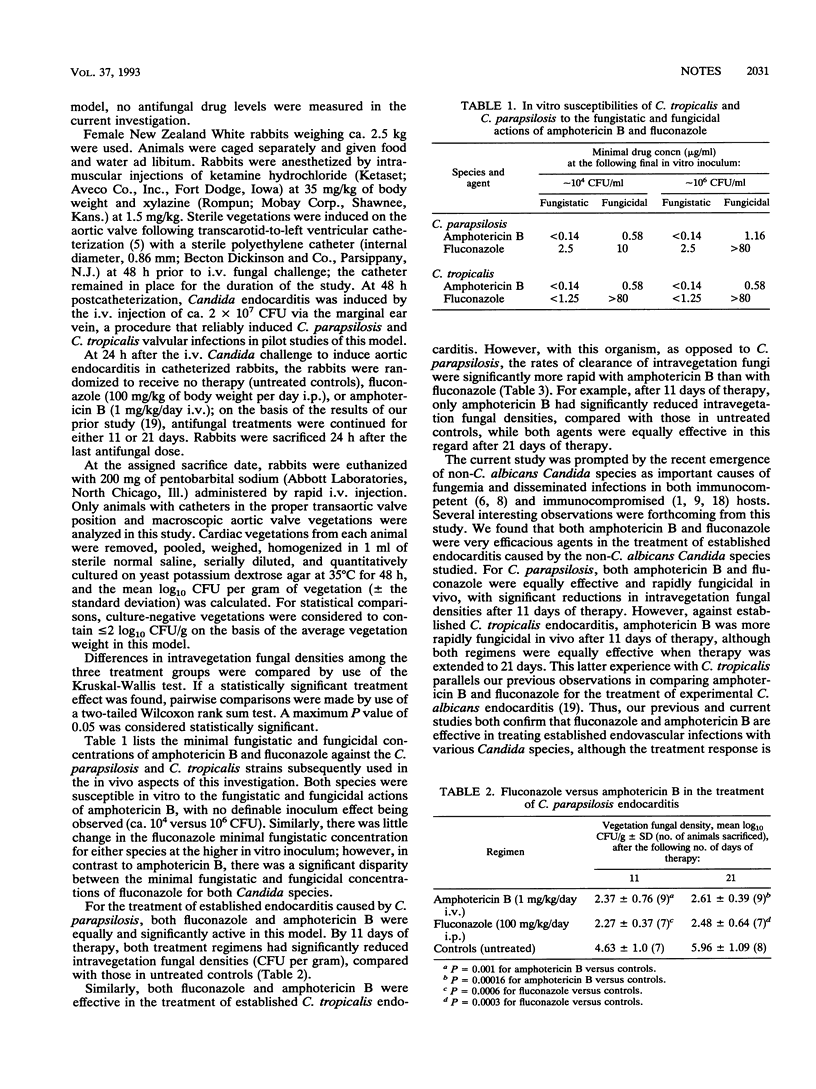Abstract
Amphotericin B and fluconazole were compared for the treatment of experimental Candida endocarditis caused by Candida tropicalis and C. parapsilosis. Rabbits received no therapy, amphotericin B (1 mg/kg of body weight per day intravenously), or fluconazole (100 mg/kg/day intraperitoneally) for either 11 or 21 days. Against both species, amphotericin B and fluconazole were equally effective overall; however, amphotericin B was more rapidly fungicidal than fluconazole in vivo against C. tropicalis.
Full text
PDF


Selected References
These references are in PubMed. This may not be the complete list of references from this article.
- Blinkhorn R. J., Adelstein D., Spagnuolo P. J. Emergence of a new opportunistic pathogen, Candida lusitaniae. J Clin Microbiol. 1989 Feb;27(2):236–240. doi: 10.1128/jcm.27.2.236-240.1989. [DOI] [PMC free article] [PubMed] [Google Scholar]
- Crislip M. A., Edwards J. E., Jr Candidiasis. Infect Dis Clin North Am. 1989 Mar;3(1):103–133. [PubMed] [Google Scholar]
- Doscher W., Krishnasastry K. V., Deckoff S. L. Fungal graft infections: case report and review of the literature. J Vasc Surg. 1987 Oct;6(4):398–402. doi: 10.1067/mva.1987.avs0060398. [DOI] [PubMed] [Google Scholar]
- Durack D. T., Beeson P. B., Petersdorf R. G. Experimental bacterial endocarditis. 3. Production and progress of the disease in rabbits. Br J Exp Pathol. 1973 Apr;54(2):142–151. [PMC free article] [PubMed] [Google Scholar]
- Edwards J. E., Jr, Filler S. G. Current strategies for treating invasive candidiasis: emphasis on infections in nonneutropenic patients. Clin Infect Dis. 1992 Mar;14 (Suppl 1):S106–S113. doi: 10.1093/clinids/14.supplement_1.s106. [DOI] [PubMed] [Google Scholar]
- Gallis H. A., Drew R. H., Pickard W. W. Amphotericin B: 30 years of clinical experience. Rev Infect Dis. 1990 Mar-Apr;12(2):308–329. doi: 10.1093/clinids/12.2.308. [DOI] [PubMed] [Google Scholar]
- Komshian S. V., Uwaydah A. K., Sobel J. D., Crane L. R. Fungemia caused by Candida species and Torulopsis glabrata in the hospitalized patient: frequency, characteristics, and evaluation of factors influencing outcome. Rev Infect Dis. 1989 May-Jun;11(3):379–390. doi: 10.1093/clinids/11.3.379. [DOI] [PubMed] [Google Scholar]
- Powderly W. G., Kobayashi G. S., Herzig G. P., Medoff G. Amphotericin B-resistant yeast infection in severely immunocompromised patients. Am J Med. 1988 May;84(5):826–832. doi: 10.1016/0002-9343(88)90059-9. [DOI] [PubMed] [Google Scholar]
- Rotrosen D., Calderone R. A., Edwards J. E., Jr Adherence of Candida species to host tissues and plastic surfaces. Rev Infect Dis. 1986 Jan-Feb;8(1):73–85. doi: 10.1093/clinids/8.1.73. [DOI] [PubMed] [Google Scholar]
- Rubinstein E., Noriega E. R., Simberkoff M. S., Holzman R., Rahal J. J., Jr Fungal endocarditis: analysis of 24 cases and review of the literature. Medicine (Baltimore) 1975 Jul;54(4):331–334. [PubMed] [Google Scholar]
- Saag M. S., Dismukes W. E. Azole antifungal agents: emphasis on new triazoles. Antimicrob Agents Chemother. 1988 Jan;32(1):1–8. doi: 10.1128/aac.32.1.1. [DOI] [PMC free article] [PubMed] [Google Scholar]
- Seelig M. S., Kozinin P. J., Goldberg P., Berger A. R. Fungal endocarditis: patients at risk and their treatment. Postgrad Med J. 1979 Sep;55(647):632–641. doi: 10.1136/pgmj.55.647.632. [DOI] [PMC free article] [PubMed] [Google Scholar]
- Seelig M. S., Speth C. P., Kozinn P. J., Taschdjian C. L., Toni E. F., Goldberg P. Patterns of Candida endocarditis following cardiac surgery: Importance of early diagnosis and therapy (an analysis of 91 cases). Prog Cardiovasc Dis. 1974 Sep-Oct;17(2):125–160. doi: 10.1016/0033-0620(74)90027-9. [DOI] [PubMed] [Google Scholar]
- Tucker R. M., Williams P. L., Arathoon E. G., Levine B. E., Hartstein A. I., Hanson L. H., Stevens D. A. Pharmacokinetics of fluconazole in cerebrospinal fluid and serum in human coccidioidal meningitis. Antimicrob Agents Chemother. 1988 Mar;32(3):369–373. doi: 10.1128/aac.32.3.369. [DOI] [PMC free article] [PubMed] [Google Scholar]
- Turnier E., Kay J. H., Bernstein S., Mendez A. M., Zubiate P. Surgical treatment of Candida endocarditis. Chest. 1975 Mar;67(3):262–268. doi: 10.1378/chest.67.3.262. [DOI] [PubMed] [Google Scholar]
- Wiley E. L., Hutchins G. M. Superior vena cava syndrome secondary to Candida thrombophlebitis complicating parenteral alimentation. J Pediatr. 1977 Dec;91(6):977–979. doi: 10.1016/s0022-3476(77)80908-6. [DOI] [PubMed] [Google Scholar]
- Wingard J. R., Merz W. G., Saral R. Candida tropicalis: a major pathogen in immunocompromised patients. Ann Intern Med. 1979 Oct;91(4):539–543. doi: 10.7326/0003-4819-91-4-539. [DOI] [PubMed] [Google Scholar]
- Witt M. D., Bayer A. S. Comparison of fluconazole and amphotericin B for prevention and treatment of experimental Candida endocarditis. Antimicrob Agents Chemother. 1991 Dec;35(12):2481–2485. doi: 10.1128/aac.35.12.2481. [DOI] [PMC free article] [PubMed] [Google Scholar]


